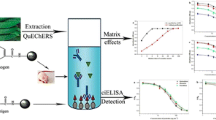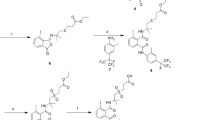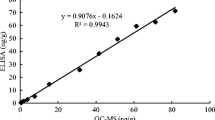Abstract
A sensitive direct enzyme-linked immunosorbent assay (ELISA) for the specific detection of 2,2′,4,4′-tetrabromodiphenyl ether (BDE-47) in environmental samples was developed. A hapten mimicking BDE-47 was synthesized by introducing a butyric acid spacer into 5-hydroxy-BDE-47 and coupled to keyhole limpet hemocyanin to form an immunogen for the production of monoclonal antibodies (Mabs) against BDE-47. The most sensitive direct ELISA was formatted with a Mab, designated as 4F2, in combination with 5-(2,4-dibromophenoxy)pentanoic acid peroxidase as a tracer. The inhibition half-maximum concentrations and limit of detection of BDE-47 in phosphate buffered saline with 25% DMSO were 1.4 ± 0.05 and 0.1 ng mL−1, respectively. Cross-reactivity values of the ELISA with the tested BDE congeners and metabolites were ≤5.8%. This assay was used to determine BDE-47 in soil, sediment and house dust samples after ultrasonic extraction, simple cleanup and concentration steps. The average recoveries, repeatabilities (intraday extractions and analyses), and intra-laboratory reproducibilities (interday extractions and analyses) were in a range of 92–126%, 8–19% and 9–25%, respectively. Applied to 44 real samples, the results of this assay displayed a statistically significant correlation with those of a gas chromatography–mass spectrometry method (R 2 = 0.79-0.85), indicating this ELISA is a suitable tool for environmental analyses of BDE-47.

Direct competitive ELISA




Similar content being viewed by others
References
Ad hoc working group on pentabromodiphenyl ether under the Persistent Organic Pollutants Review Committee of the Stockholm Convention, United Nations Environment Programme, August 2007
de Wit CA (2002) Chemosphere 46:583–624
EEC, Directive 2003/11/EC of the European Parliament and of the Council of 6 February 2003 amending for the 24th time Council directive 76/769/EEC relating to restrictions on the marketing and use of certain dangerous substances and preparations (pentabromodiphenyl ether and octabromodiphenyl ether), Official Journal L042, 15/02/2003
California State Assembly, Assembly Bill No. 302. Sacramento, C.A.: California State Assembly, 2003
European Court of Justice, Cases C-14/06 and C-295/06, Judgement of the Court, 1 April 2008, Directive 2002/95/EC and Commission Decision 2005/717/EC, 2008
Hites RA (2004) Environ Sci Technol 38:945–956
Zegers BN, Lewis WE, Booij K, Smittenberg RH, Boer W, de Boer J, Boon JP (2003) Environ Sci Technol 37:3803–3807
Lacorte S, Guillamon M (2008) Chemosphere 73:70–75
Thorenz UR, Musa Bandowe BA, Sobocka J, Wilcke W (2010) Environ Pollut 158:2208–2217
Losada S, Parera J, Abalos M, Abad E, Santos FJ, Galceran MT (2010) Anal Chim Acta 678:73–81
Lacorte S, Ikonomou MG, Fischer M (2010) J Chromatogr A 1217:337–347
Gómara B, Herrero L, Bordajandi LR, González MJ (2006) Rapid Commun Mass Spectrom 20:69–74
Wang D, Li QX (2010) Mass Spectrom Rev 29:737–775
Sánchez-Brunete C, Miguel E, Tadeo JL (2006) Talanta 70:1051–1056
Tadeo JL, Sánchez-Brunete C, Miguel E (2009) Talanta 78:138–143
Ahn K-C, Gee SJ, Kim H-J, Nichkova M, Lee NA, Hammock BD (2007) ACS Symp Ser 966:138–154
Chiu Y-W, Carlson RE, Marcus KL, Karu AE (1995) Anal Chem 67:3829–3839
Glass TR, Ohmura N, Saiki H, Sawadaishi K, Kataoka C, Takagi Y, Ohiwa T (2004) Anal Chim Acta 517:161–168
Van Emon JM, Chuang JC, Lordo RA, Schrock ME, Nichkova M, Gee SJ, Hammock BD (2008) Chemosphere 72:95–103
Matsui K, Kawaji I, Utsumi Y, Ukita Y, Asano T, Takeo M, Kato D, Negoro S (2007) J Biosci Bioeng 104:347–350
Shelver WL, Keum Y-S, Kim H-J, Rutherford D, Hakk HH, Bergman Å, Li QX (2005) J Agric Food Chem 53:3840–3847
Shelver WL, Parrotta CD, Slawecki R, Li QX, Ikonomou MG, Barcelo D, Lacorte S, Rubio FM (2008) Chemosphere 73:S18–S23
Ahn K-C, Gee SJ, Tsai H-J, Bennett D, Nishioka MG, Blum A, Fishman E, Hammock BD (2009) Environ Sci Technol 43:7784–7790
Xu T, Cho I-K, Wang D, Rubio FM, Shelver WL, Gasc AME, Li J, Li QX (2009) Environ Pollut 157:417–422
Kim H-J, Rossotti MA, Ahn K-C, González-Sapienza GG, Gee SJ, Musker R, Hammock BD (2010) Anal Biochem 401:38–46
Marsh G, Stenutz R, Bergman Å (2003) Eur J Org Chem 14:2566–2576
McAdam DP, Hill AS, Beasley HL, Skerritt JH (1992) J Agric Food Chem 40:1466–1470
Fránek M, Deng A, Kolár V, Socha J (2001) Anal Chim Acta 444:131–142
Gaur PK, Lau HP, Pestka JJ, Chu FS (1981) Appl Enuiron Microbiol 41:478–482
Webster T, Vieira V, Schecter A (2005) Organohalog Compd 67:505–508
Allen JG, McClean MD, Stapleton HM, Nelson JW, Webster TF (2007) Environ Sci Technol 41:4574–4579
Lorber M (2008) J Expo Sci Environ Epidemiol 18:2–19
Brun EM, Garcés-García M, Puchades R, Maquieira A (2004) J Immunol Methods 295:21–35
ISO (1994) 5725–2: Accuracy (truness and precision) of measurement methods and results. Part 2: Basic method for the determination of repeatability and reproducibility of a standard measurement method
Alcocka RE, Sweetmanb AJ, Prevedourosb K, Jones KC (2003) Environ Int 29:691–698
Meeker JD, Johnson PI, Camann D, Hauser R (2009) Sci Total Environ 407:3425–3429
Acknowledgements
This work was supported in part by the National Natural and Science Foundation of China (No. 20977111) and the Chinese University Scientific Fund (No. 2009TD15).
Author information
Authors and Affiliations
Corresponding author
Electronic supplementary material
Below is the link to the electronic supplementary material.
ESM 1
(PDF 60.9 kb)
Rights and permissions
About this article
Cite this article
Wang, J., Li, H., Shelver, W.L. et al. Development of a monoclonal antibody-based, congener-specific and solvent-tolerable direct enzyme-linked immunosorbent assay for the detection of 2,2′,4,4′-tetrabromodiphenyl ether in environmental samples. Anal Bioanal Chem 401, 2249–2258 (2011). https://doi.org/10.1007/s00216-011-5283-x
Received:
Revised:
Accepted:
Published:
Issue Date:
DOI: https://doi.org/10.1007/s00216-011-5283-x




